47 Different Types of Fruits (With Pictures)
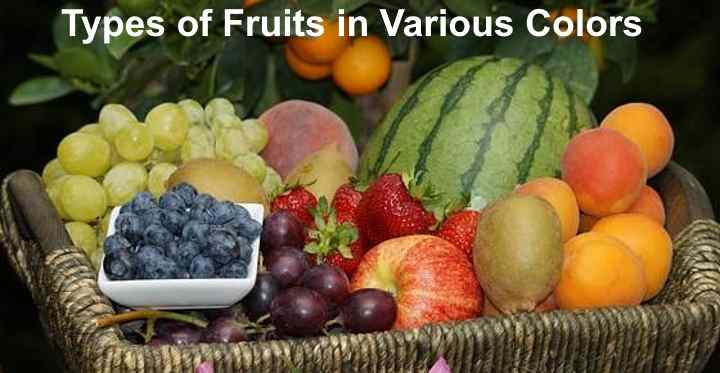
Fruits come in many different varieties and flavors, making them a delicious and nutritious part of our diet. From sweet and juicy apples and oranges to tart berries and tropical fruits, there is a fruit to suit everyone’s taste. Some common types of fruits include apples, oranges, bananas, strawberries, grapes, watermelons, pineapples, mangoes, and peaches.
Each type of fruit has unique characteristics, like color, texture, and taste. Whether you eat them fresh or use them in cooking, fruits are a versatile and healthy addition to any meal.
This article explores the different types of fruits available. You will learn about different colored fruits like pomes, berries, drupes, hesperidina, and accessory fruits.
Types of Red Fruits
Red fruits are colorful, ripe fruits with a vibrant red hue. The red color in fruits is often due to pigments like anthocyanins and lycopene. Common types of red fruits include strawberries, apples, cherries, raspberries, currants, and grapes.
Strawberry (Fragaria ananassa)

Strawberries are a popular type of fruit known for their vibrant red color and sweet, juicy flavor. They are a type of red accessory fruit with a heart shape and many tiny seeds embedded in the skin. Strawberries grow on low-lying plants with green foliage and ripen in the summer.
Strawberries typically measure 1.2” to 1.6” (3 – 4 cm) in diameter. The bright red color and glossy appearance of strawberries make them visually appealing. The fruit’s juicy texture adds to their enjoyment. When selecting strawberries, look for firm and plump ones with a bright red color.
You can enjoy fresh red strawberries on their own or as a topping for desserts like cakes, pies, and ice cream. Strawberries can also be incorporated into smoothies, salads, and jam-making.
Raspberry (Rubus)

Raspberries are small, red, edible, berry-like fruits that grow on thorny shrubs, although thornless varieties are available too. Ripe raspberry fruits have a sweet and slightly tart flavor and juicy texture. The small aggregate fruits measure around 0.4” (1 cm) long and contain up to 100 drupelets, each containing a single seed.
Raspberries are a good source of dietary fiber, vitamin C, and antioxidants. The red fruits are delicious as a snack or used in baked products like pies, tarts, and cakes. Additionally, raspberry jams, jellies, and sauces are highly popular.
Because of their short shelf life, raspberries are commonly frozen. This process makes adding them to smoothies, yogurt, or cereal easy for a burst of flavor and added nutrition.
Raspberry bushes are relatively easy to grow, making them popular for home gardeners. They require well-drained soil and prefer full sun or partial shade. Raspberries are typically harvested in the summer when they are ripe and easily detach from the plant.
Red Apple (Malus domestica)

Red apples are one of the most widely consumed fruits worldwide. The round or oval-shaped pome fruits have a thin red skin surrounding crisp, juicy flesh. Common varieties of red apples include Gala, Red Delicious, Honeycrisp, Pink Lady, and Fuji. Red apple’s average size is 2.7” to 3.3” (7 – 8.5 cm) in diameter.
Red apples have a balanced sweet-tart flavor. However, the taste of red apples depends on the specific cultivar. Some red varieties are exceedingly sweet, whereas others, like Macintosh apples, are tart. Red apples make a healthy and portable snack option for people of all ages.
Some of the smallest red apple varieties are crabapples.
Red Cherry (Prunus cerasus or Prunus avium)
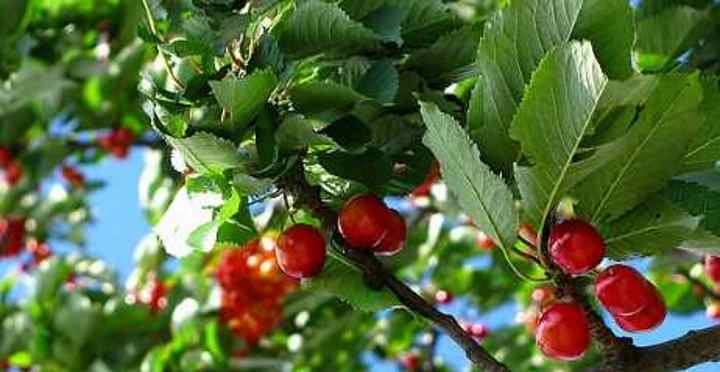
Red cherries are small, round drupes with a sweet or tart fleshy body, thin red skin, and a hard stone. The stone fruits can be various shades of red, from vibrant, bright red to deep burgundy. Red cherries grow in small clusters and ripen in summer when the stems easily pull off the tree.
The glossy red fruits measure 0.5” to 0.75” (1.3 – 2 cm) in diameter. Cherries are known for their juicy flesh that is firm and slightly crisp. Depending on the variety, red cherries can be sweet or sour.
Sweet red cherries (Prunus avium): These heart-shaped red fruits have a glossy appearance and juicy, succulent flesh. They taste delightfully sweet with hints of tartness. They range in color from bright red to dark purple, almost black.
Sour red cherries (Prunus cerasus): These small, round, bright red fruits are smaller than sweet cherries. They have an intense tart taste with a hint of sweetness. Sour cherries are commonly used in culinary applications, such as pies and preserves.
Cranberry (Vaccinium oxycoccos)
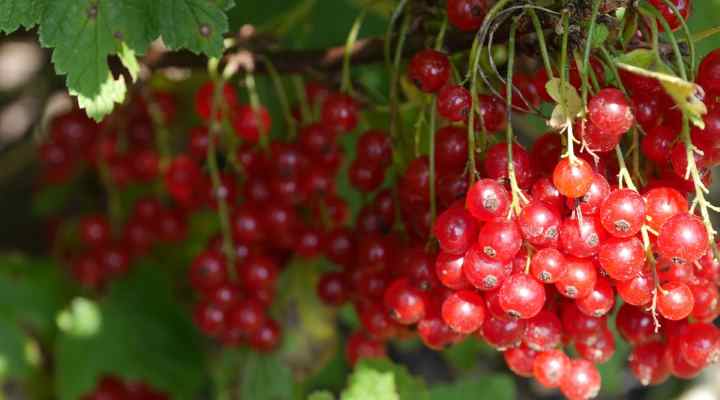
Cranberries are small, round, deep red berries that grow on low shrubs in bogs and marshes. The red berries have a glossy appearance and measure 0.5” (1.3 cm) in diameter. Red cranberries have a distinct tart flavor and can taste slightly bitter or sour. The red berry plants thrive in cold, temperate climates.
Cranberries are also called marshberries, bog cranberries, or swamp cranberries. Due to their sourness, they are sweetened to create sauces, jams, and health juices. Cranberry sauce is also a common condiment that complements turkey, chicken, and pork dishes.
Redcurrant (Ribes rubrum)

Redcurrants are small, bright red berries that grow in clusters on deciduous shrubs. Like cranberries, red currants have a tart flavor with hints of sweetness. The shiny red berries grow in dense clusters, dangling in rows from the small shrubs. The round red berries measure 0.31” to 0.47” (0.8 – 1.2 cm) in diameter.
Native to Europe, redcurrants are a rich source of vitamin C. The sourness of the berries makes them ideal as a cooking and baking ingredient. Popular ways to consume redcurrants include flavorful jams, jellies, sauces, and desserts. Their tartness can add a burst of tangy flavor to savory and sweet dishes.
Redcurrants are fully ripe in summer. Despite their tartness, there is enough sweetness to enjoy the little red fruits fresh from the shrub.
Red Grape (Vitis)
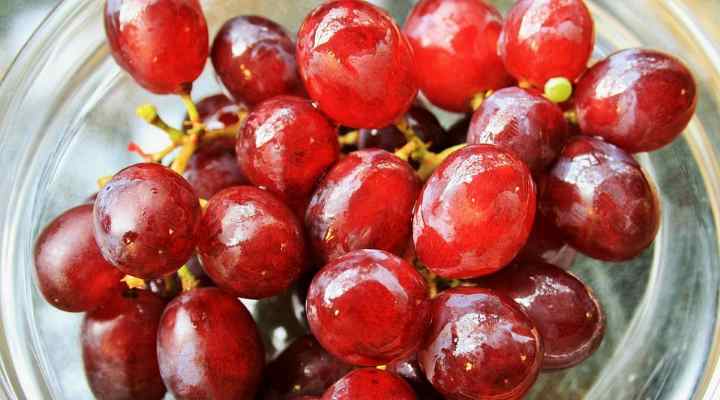
Red grapes are red berry fruits that grow in large clusters on fast-growing woody vines. Grape varieties can be red, green, or purple. The round berries measure between 0.24” and 1.2” (0.6 – 3 cm) in diameter. Red grapes are known for their vibrant, deep red color and sweet flavor.
Red grapes have a juicy, sweet flesh with a slightly tart taste. Due to their red or dark purple color, red grape skins are packed with antioxidants and phenolic compounds. They also have various culinary uses—from snacking to making juice, wine, and jams. Additionally, red grapes are a popular dried food sold as black raisins.
Types of Green Fruits
Green fruits like limes, grapes, and avocados are packed with nutrients like vitamin C and potassium. They are also a good source of fiber, which aids digestion. And their nutritious, tasty flesh helps support a healthy, balanced diet.
Green Grape (Vitis)
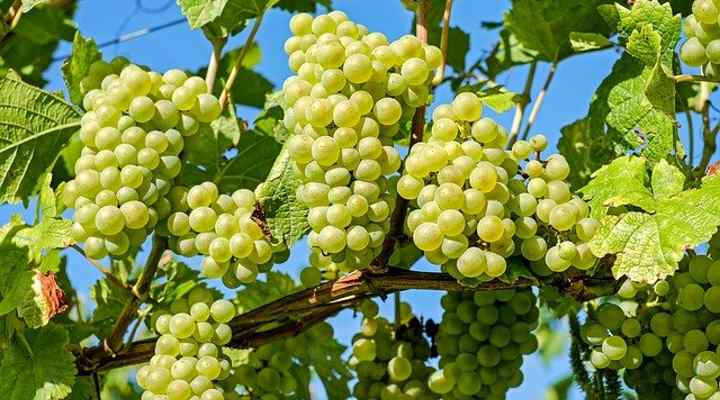
Green grapes are a type of green berry with sweet, juicy flavors. The round or oval-shaped berries typically have a crisp, firm texture. Depending on the grape variety, they can be seedless or contain small, edible seeds. There can be between 70 and 100 green grapes in a typical cluster.
The main difference between green and red grapes is their skin color. Both varieties have juicy flesh that is a light green or yellow-green color. However, due to the red color of the skin, red and purple grapes have more antioxidants. Red and green grapes have similar amounts of vitamins and minerals.
Common Pear (Pyrus communis)
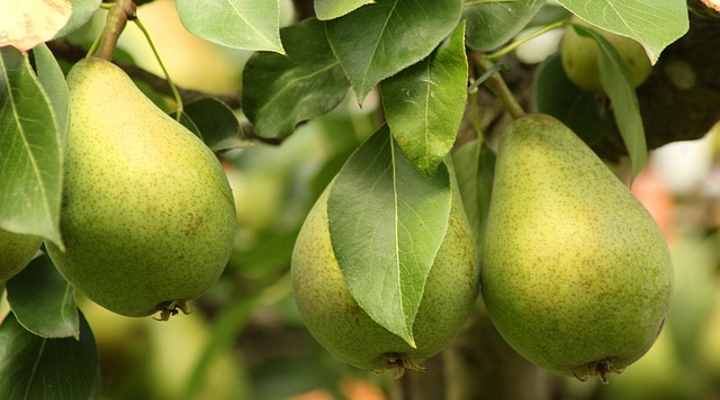
Pears are a type of green pome fruit with a distinctive shape—a round bottom and tapering top—that grow on pear trees. Pears are known for their sweet, juicy flesh with a taste containing hints of honey, citrus, and vanilla. The pear’s crisp flesh can be smooth or slightly grainy in texture.
Pears make a delicious snack or addition to fruit salads. However, the versatile green fruits work well in sweet and savory dishes. For example, poached pears are a delicious dessert, and baked pears go well with pork, chicken, and cheese dishes.
When selecting pears, look for ones that are firm but slightly soft to the touch. They are a versatile and nutritious fruit you can enjoy in a variety of ways. Whether eaten fresh or cooked, pears offer a sweet and juicy flavor that will delight the taste buds.
Lime

Limes are a type of small, green citrus fruit with a tangy, sour taste and a refreshing aroma. Typically round or oval, green limes are slightly larger than a golf ball, up to 2.5” (6 cm) in diameter. Limes are known for their vibrant green color, although some varieties turn yellow when fully ripened.
Green limes are a type of hesperidium—a modified berry with a thick rind covering a juicy body. Like other citrus fruits, limes have oil glands in the pits, giving a tart, zesty kick to marinades, dressings, and sauces. Lime juice is often squeezed over seafood and used in cocktails like margaritas.
Here are some popular varieties of green limes:
Persian lime (Citrus × latifolia): These green fruits are round to oval in shape and are the most widely cultivated lime variety. They measure 2.5” (6 cm) in diameter. The skin is deep green and turns yellow as it ripens.

Persian limes
Kaffir Lime (Citrus hystrix): Easily recognizable by its dark green color and knobby rind that emits a strong citrusy fragrance. The small green fruits measure 2” (5 cm) in diameter.
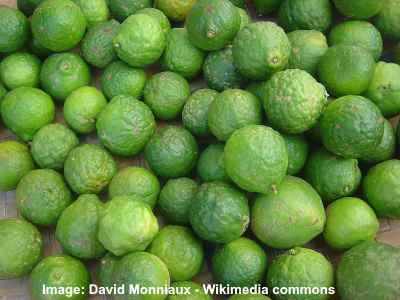
Kaffir Limes
Finger Lime (Citrus australasica): This unusual lime is a green, oblong fruit containing juicy pearl-like balls of lime juice. The green fruits measure up to 3.1” (8 cm) long.
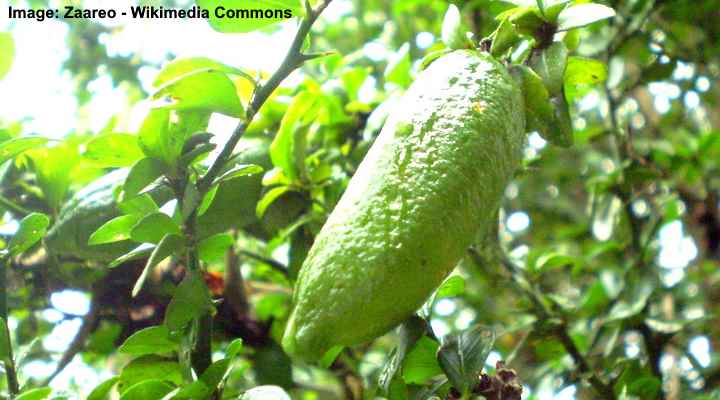
Finger lime
Key lime (Citrus aurantiifolia): This popular variety of lime has a spherical shape and measures 1” to 2” (2.5 – 5 cm) in diameter. Compared to Persian limes, it is smaller and contains more seeds.

Key lime on the tree (left) and ripe yellow Key lime (right). When ripe, the color of this type of lime is bright yellow
Gooseberry (Ribes uva-crispa)
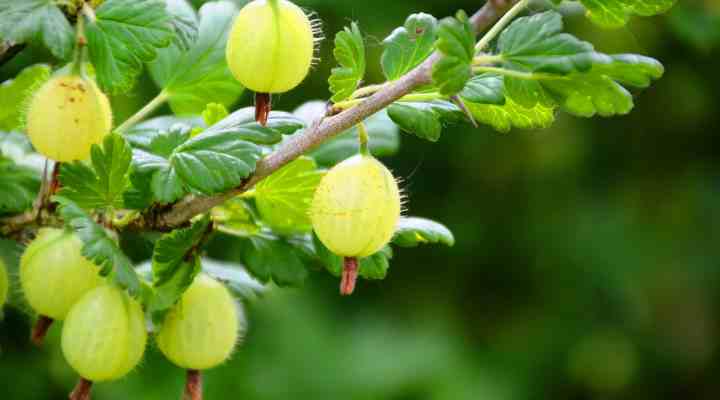
Gooseberries are small, round to oval berry fruits containing seeds and have a sweet, slightly tart taste. The tangy green fruits grow on thorny shrubs, measuring around 0.5” (1.25 cm) long. When ripe, green gooseberries are tart compared to gooseberries of other colors, which are sweeter and juicier.
Gooseberries are versatile fruits you can enjoy in various ways. You can consume them fresh, use them to make jams and jellies or preserve the green fruits by pickling or bottling. Some varieties of gooseberries are too tart for eating raw, making them better suited for cooking and baking.
They are rich in vitamin C and B6 and dietary fiber.
Avocado (Persea americana)

Avocado is a green fruit shaped like a pear. Botanically speaking, avocados are large single-seeded berries used like vegetables. The pear-like fruit has a dark-green smooth to bumpy skin and can ripen to dark green, almost black. The dark green avocado fruits typically measure 3” to 8” (7 – 20 cm) long.
Sweet Green Oranges (Citrus reticulata × sinensis)

Although considered orange fruits, green oranges are a unique type of hesperidium fruit. The citrus fruit has a thick, lime-like rind covering tangy orange flesh. The orange segments taste like sweet tangerines. Sweet green oranges are a hybrid citrus fruit developed by crossing a sweet orange and a tangerine.
Breadfruit (Artocarpus altilis)

Breadfruit is a tropical fruit with green, bumpy skin and the size of a grapefruit. The large, round, oblong, or oval green fruits grow on tall trees 85 ft. (26 m) tall. Breadfruit flesh is soft and pale with a starchy texture and a sweet flavor like freshly baked bread or potatoes.
Breadfruit measures 4” to 12” (10 – 30 cm) in diameter and can weigh up to 13 lbs. (6 kg). It is closely related to other fruits in the mulberry family—jackfruit, breadnut, and cempedak fruit.
In tropical regions, breadfruit is a staple, versatile food. It can be baked, boiled, or roasted, similar to cooking potatoes. The cooked fruit can be mashed, fried, or made into dishes like breadfruit fries or breadfruit salad.
Types of Yellow Fruits
Yellow fruits, like bananas, lemons, and mangoes, derive their color from pigments like lutein, zeaxanthin, and carotenoids. Carotenoids serve as antioxidants and contribute to plant photosynthesis. Fruits with yellow skin or flesh are also rich in vitamins A and C.
Banana (Musa)

Bananas can be classed as yellow fruits due to their peel, or white fruits due to their creamy flesh. The tropical fruits are easily recognizable due to their elongated, curved shape and bright yellow skin. The yellow fruit has soft, pulpy flesh with flavors reminiscent of candy, pineapple, melon, and honey.
The taste of bananas varies depending on their ripeness. Green or unripe bananas have a starchy taste and are often used in cooking. However, as bananas ripen, they become sweeter and develop a more pronounced flavor. Yellow bananas are popular for snacking, adding to smoothies, or using in cooking.
Bananas are low in calories and rich in nutrients such as potassium, vitamin C, vitamin B6, and dietary fiber.
Asian Pear (Pyrus pyrifolia)

Asian pear is a round, juicy fruit known for its crisp texture and sweet, refreshing flavor. Asian pears are typically larger and rounder than European pears. They are characterized by yellow-green or yellowish-brown skins. They have white or creamy-white flesh that is crunchy, sweet, and slightly tart.
Asian pears are also called nashi pears, Japanese pears, and papples. They are different from traditional European pears in appearance and texture. The large, round pomes look more like apples. They also have a crisp, grainy texture with a high water content. They are typically consumed as a refreshing snack and are rarely used in cooking.
Lemon (Citrus limon)

Lemons are bright yellow citrus fruits with juicy, fleshy segments and a tangy, somewhat sour taste. Lemons are easily identified by their oval to oblong shape and thick yellow rind. Some lemons can taste sweet with little acidity, depending on the cultivar. The lemon rind contains pits filled with essential oils.
Yellow lemons measure 2” to 3” (5 to 8 cm) in diameter. Lemon juice is known for its acidity—it’s five times more acidic than orange juice and slightly more acidic than lime juice. Lemons are high in vitamin C content, with an average lemon containing about 60 percent of the recommended daily intake.
Grapefruit (Citrus x paradisi)

Grapefruit is a large, round citrus or hesperidium fruit known for its sour, bitter, but slightly sweet taste. The large round, pale, yellow-skinned fruits measure 4” to 6” (10 – 15 cm) in diameter. They grow in grape-like clusters on evergreen trees and ripen between November and March.
Grapefruits are hybrid citrus fruits resulting from crossbreeding a pomelo and a sweet orange. Depending on the cultivar, the spongy rind and flesh can be yellow, pinkish-red to deep red.
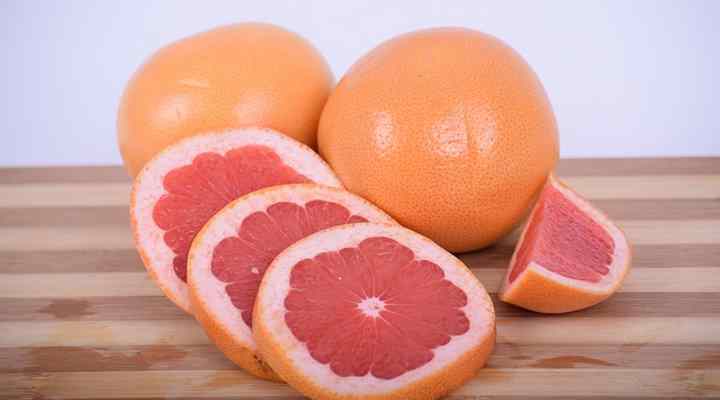
Red grapefruit (Citrus x paradisi)
Consuming fresh grapefruit is a refreshing experience. The flesh is juicy and slightly acidic and has a unique flavor due to its balance of sweetness and acidity. You only need to cut the fruit in half and scoop out the flesh using a spoon to enjoy its taste.
It’s worth noting that grapefruit can interact with certain medications. So, if you are on any medication, it is important to check with your healthcare provider before consuming grapefruit or its juice.
Canary Melon (Cucumis melo)
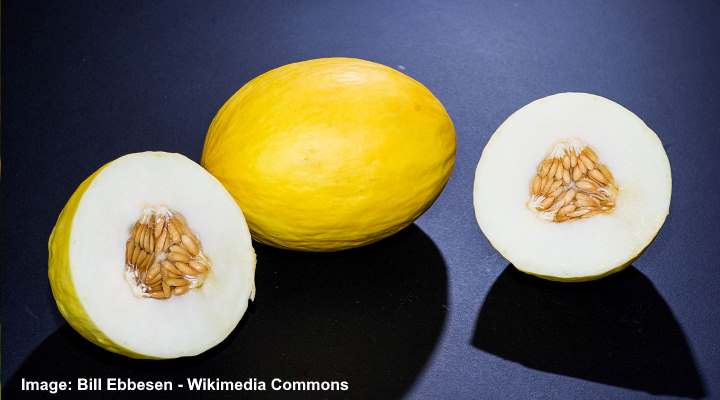
Canary melon is a type of pepo fruit with a vibrant yellow rind and white, sweet, juicy flesh. Characteristics of the bright yellow melon are its smooth skin, white flesh with a slightly tangy taste, and a mass of tan-colored seeds in the center.
The large canary-yellow melon grows up to 5” (13 cm) across and weighs 5 lbs. (2 kg). Like most types of melons, the canary melon has a high water content, contributing to its juicy and thirst-quenching nature. As a variety of muskmelon, this type has a mild and slightly musky aroma, adding to its appeal.
Pineapple (Ananas comosus)

Pineapple is classed as a yellow tropical fruit due to its juicy, crisp, pale yellow flesh. A typical pineapple has a rough exterior made up of multiple flowers that fuse together. It has an easily recognizable spiky top. Slicing a pineapple open reveals golden yellow to pale yellow flesh.
The flesh of a pineapple is yellow or white, depending on the variety, and is sweet and juicy. It has a tropical, citrus-like flavor with hints of sweetness and acidity. Pineapples are also rich in bromelain, which adds to their unusual flavor.
To enjoy a pineapple, cut off the top and bottom, then stand it upright on a cutting board. Use a sharp knife to carefully slice off the skin, following the fruit’s contour. Once the skin is removed, you can cut the pineapple into rings, cubes, or any desired shape.
Types of Orange Fruits
Oranges, apricots, and peaches are among the tastiest orange fruits. Like all berries, drupes, and citrus fruits, orange-colored fruits are exceedingly healthy.
Orange (Citrus × sinensis)

Oranges are a type of citrus fruit with a vibrant orange rind and orange flesh with a sweet, tangy flavor. Oranges are round with thick, textured, spongy skin covering triangular, fleshy, juice-filled segments. Depending on the variety of oranges, the hesperidium fruits can taste sweet or tart.
Oranges are delicious and packed with nutrients, especially vitamin C and dietary fiber. They are a tasty snack and an excellent ingredient for fruit salads. The zest and juice of oranges are commonly used in cooking and baking to add zingy flavor to dishes and desserts. Oranges are a versatile and nutritious fruit that can be enjoyed in various ways.
Mango (Mangifera)
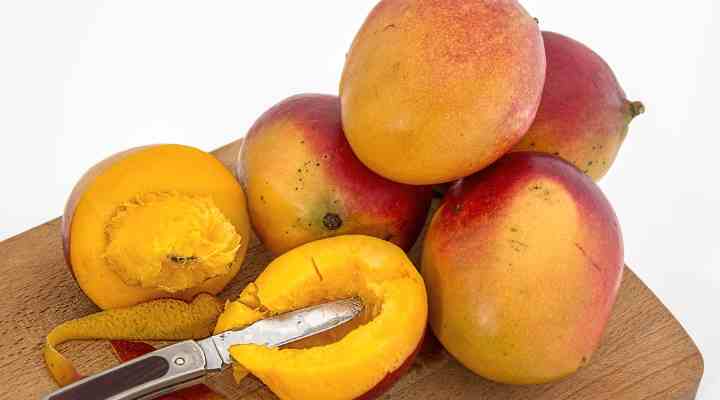
Mango is a type of tropical stone fruit known for its sweet and juicy orange to yellow flesh. The large egg-shaped fruit has a thick green, yellow or red skin covering a large, flattened stone. When ripe, mangos range in size from 3” to 5” (7.5 – 13 cm) long. Mango has a floral taste with hints of citrus, orange, peach, and melon.
Mangoes have a unique flavor profile that combines sweetness with some tartness. The flesh is smooth and fibrous, with a texture similar to a peach. Mangos are popular orange or yellow fruits for consuming fresh or to add a tropical twist to salads, salsas, desserts, and smoothies.
Mandarin (Citrus reticulata)
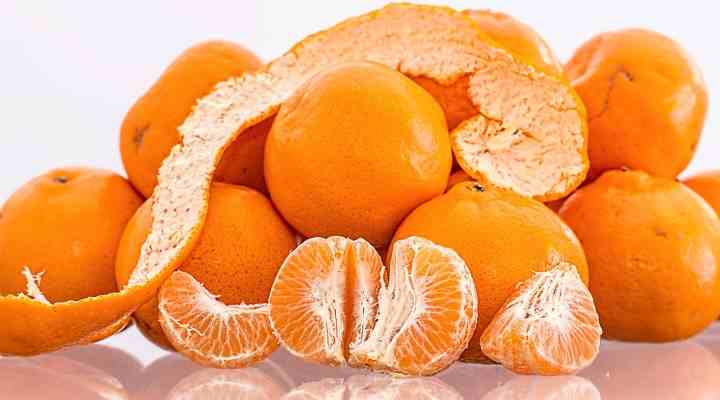
Mandarins are small citrus fruits with orange, easy-to-peel skin, and surprisingly sweet, juicy segments. Mandarins are smaller, sweeter, and easier to peel than oranges. The small orange fruits are flat-topped, spherical, and measure 1.6” to 3.1” (4 – 8 cm) in diameter.
Mandarin oranges grow on small fruit trees 25 ft. (7.6 m) tall. The vibrantly colored orange fruits contrast nicely with the tree’s shiny, deep green foliage. A mature mandarin tree can produce up to 175 lbs. (79 kg) of fruit per season.
Mandarins are a popular snack enjoyed fresh on their own or added to fruit salads. In addition to being delicious orange fruits, tangerines are also a good source of vitamin C and other antioxidants.
Peach (Prunus persica)
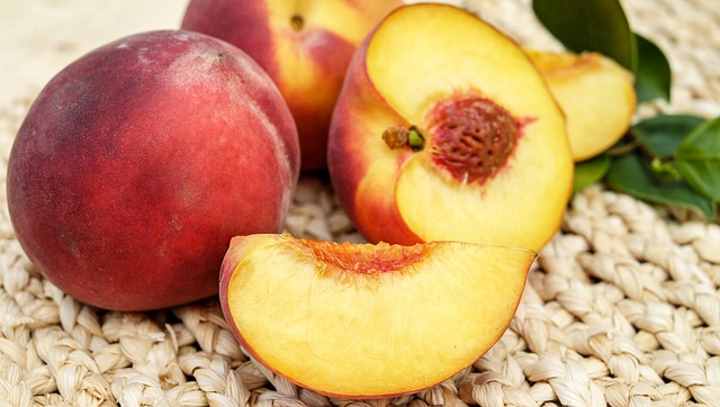
Peaches are a type of stone fruit known for their fuzzy yellow to red skin and juicy yellow-orange or white flesh. These round fruits have a single seed surrounded by a pericarp. This refers to the juicy golden-yellow flesh (mesocarp) and hard shell containing the seed (endocarp). The thin reddish-orange skin is the exocarp.
Peaches typically measure around 3” (7.5 cm) in diameter. Their soft, velvety flesh has a sweet taste and slightly acidic tang. White peaches tend to be less acidic and sweeter.
Nectarine (Prunus persica var. nucipersica)
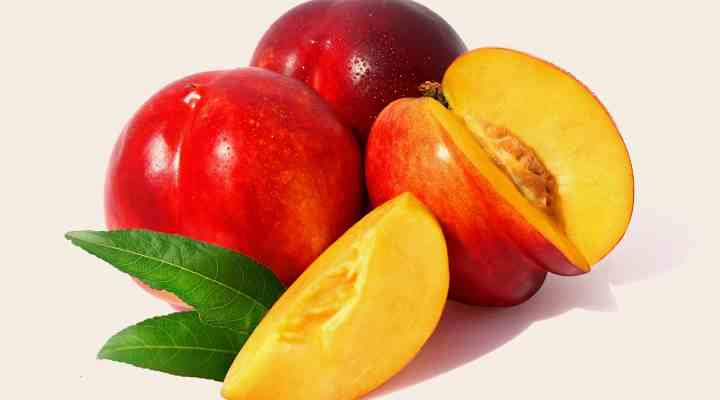
A nectarine is a type of drupe fruit that looks like a smooth peach. The round fruit has a reddish exocarp with hints of yellow surrounding juicy orange flesh. Similar to peaches, nectarines are slightly tart and have a sweet flavor. Like peaches, the stone fruit has a pericarp covering the single seed.
Types of White Fruits
White fruits like pineberries, lychees, and coconuts are nutritious because they contain nutrients such as fiber, vitamins, and minerals. These fruits offer health benefits, supporting digestion, heart health, and overall well-being.
Coconut (Cocos nucifera)

Coconuts are a type of drupe and the fruit of the large palm tree Cocos nucifera. The most recognizable part of coconut fruits is the shaggy fiber on the endocarp, commonly mistaken for a nut. The tropical fruit has pure white inner flesh and has a nutty, slightly creamy taste.
Coconuts are an extremely versatile white fruit. The tough, fibrous outer husk can be used for making doormats or mattresses. The seeds can be processed to make plant milk or oil. And the hard shell can be used to make charcoal. Also, coconut water is a nutrient and mineral-rich drink unique in the plant world.
Pineberry (Fragaria chiloensis x virginiana)

Pineberry is an unusual type of white strawberry that tastes like pineapple. The small, heart-shaped white fruits are creamy white and dotted with vibrant red seeds. Pineberries are smaller than traditional red strawberries and ripen in spring and summer. The white berry-like fruits measure 0.6″ to 0.9″ (1.5 to 2.3 cm).
Dragon Fruit (Selenicereus undatus)

Dragon fruit is a vibrant tropical fruit with bright pink skin encasing white dotted flesh with black seeds. Also known as pitaya, dragon fruit has a mildly sweet, refreshing taste resembling melon or kiwi fruit. Also, its green scaly spikes contrasting with bright pink skin make it easily recognizable.
Dragon fruit skin and flesh are edible. You can scoop out the inside and eat the white, crisp flesh. Or you can chop the entire fruit and the skin to add vibrancy and a tropical taste to fruit salads. The black-speckled flesh and hot pink skin look spectacular in salads and salsas.
Alternatively, you can choose a type of vibrant red dragon fruit (Selenicereus costaricensis). It has bright pink skin and deep red flesh.
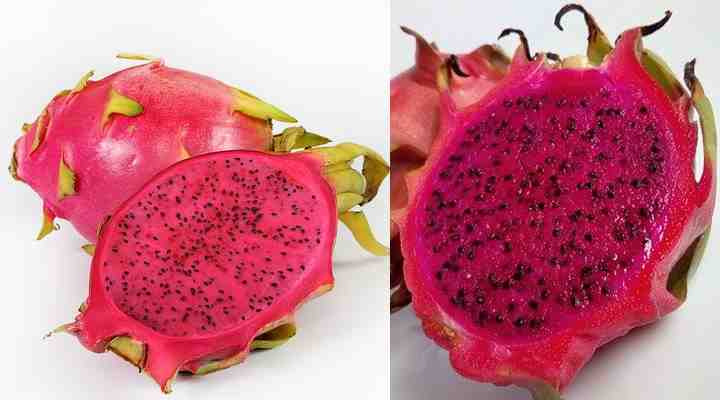
Red dragon fruit
Lychee (Litchi chinensis)
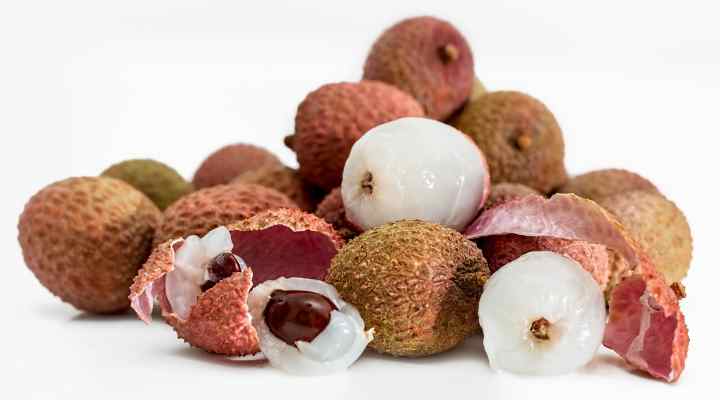
Lychee is an unusual white tropical fruit due to its crispy white flesh covered in a rough, pink-red or reddish-brown, leathery peel. The transparent white flesh has a sweet, fragrant, almost floral flavor and aroma. Also, a large, mahogany-brown seed is in the fruit’s center. Lychee fruits measure 2” (5 cm) in diameter.
Lychee fruits are native to Southeast Asia. The edible portion of the fruit is an aril—fleshy tissue surrounding the seed. The delicious white fruits are ideal for eating fresh in fruit salads and desserts. You can also use lychees to make tasty juices, smoothies, and cocktails.
Cherimoya (Custard Apple) (Annona cherimola)
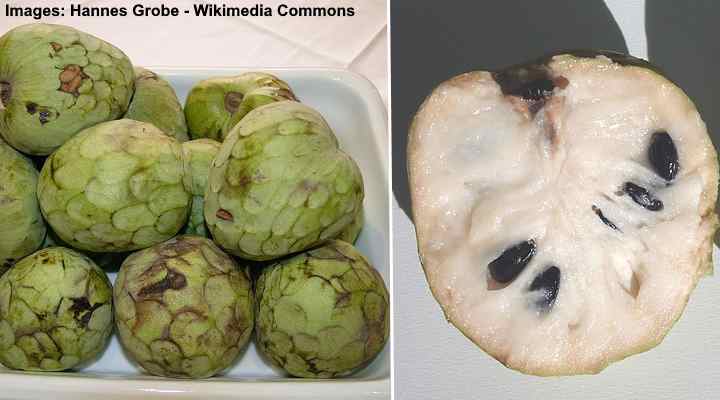
Custard apple is a white-fleshed tropical fruit with green, warty skin. This delicious part of the fruit is the white flesh with a creamy, custard-like texture that tastes like coconut, pineapple, and bananas. The fruit’s exterior is green and bumpy, resembling an artichoke.
When ripe, custard apples become softer and may have a slight yellow or brown coloration. The fruit is typically an oval or heart-shaped compound fruit measuring 4” to 8” (10 – 20 cm) long and up to 4” (10 cm) wide.
To enjoy the custard apple, cut it open and scoop out the soft, white flesh. They are also delicious ingredients for smoothies, milkshakes, and ice creams, adding a rich and creamy element.
Types of Purple and Blue Fruits
Purple fruits like figs, plums, and blueberries get their color from anthocyanins—powerful antioxidants with potential health benefits. Purple fruits are vital to a nutritious, balanced diet due to their high vitamin and macronutrient content.
Plum (Prunus domestica)

Plums are the most common type of purple drupe fruit. The purple fruits are known for their juicy yellowish-green flesh and sweet flavor. However, some plum varieties can be exceedingly sour. The oval, egg-shaped fruits grow up to 3” (7.5 cm) long and dangle from the branches of plum trees.
Varieties of deep purple plums have a particularly rich, sweet flavor. The fruit’s skin is smooth and easily peeled away to reveal the juicy flesh. Typically, plum skins are tarter than the soft and succulent flesh. However, dried plums (prunes) become exceedingly sweet.
Damson plums (Prunus domestica subsp. insititia) are a type of small purple stone fruit. Compared to common plums, they are tangier with an astringent taste.
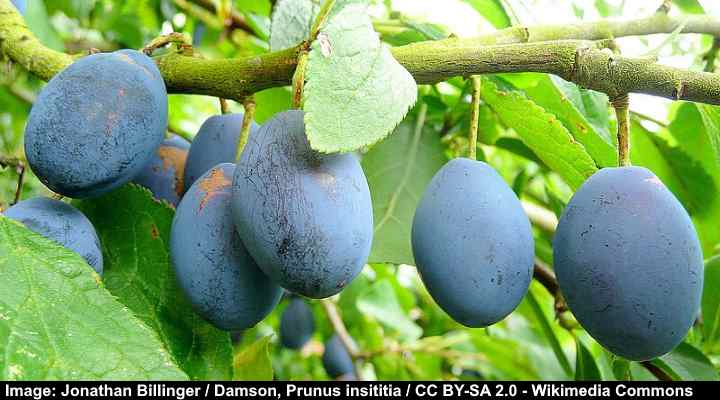
Damson plums
Fig (Ficus carica)

Figs are an unusual type of purple fruit consisting of tiny fig flowers blooming in a cup-like structure. The flowers make up the soft inside of the egg-shaped purple fruit. They have a soft and chewy texture with a slight crunch from the seeds. Fig fruit flavor ranges from honey-like sweetness to an earthy and nutty taste.
Ripe figs are a delicious snack straight from the tree. They also pair well with sweet and savory dishes, adding a delicious taste to goat’s cheese salads, tarts, jams, and cookies.
Purple Star Apple (Chrysophyllum cainito)
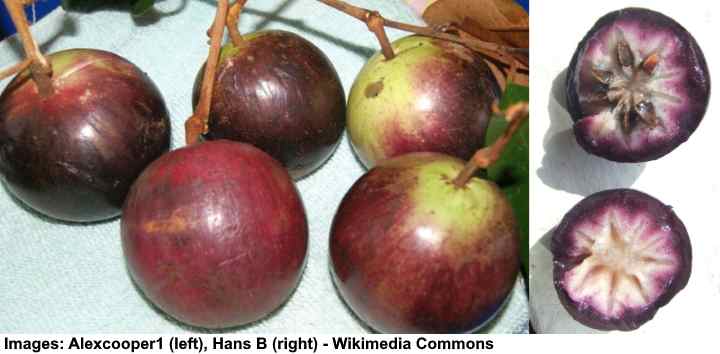
The purple star apple is an unusual tropical fruit with a globose and deep purple inedible rind with a green patch on the top. Slicing through the center of this purple fruit reveals a distinctive radiating star-shaped pattern in its purple and white flesh. The flesh has a soft, gelatinous pulp.
Round purple star apples measure 2” to 3” (5 – 7.5 cm) in diameter. Its creamy, smooth texture tastes like grapes and tropical fruits. The purple fruit is typically consumed fresh or used to make preserves that have a sweet, pleasant flavor.
Passion Fruit (Passiflora edulis)
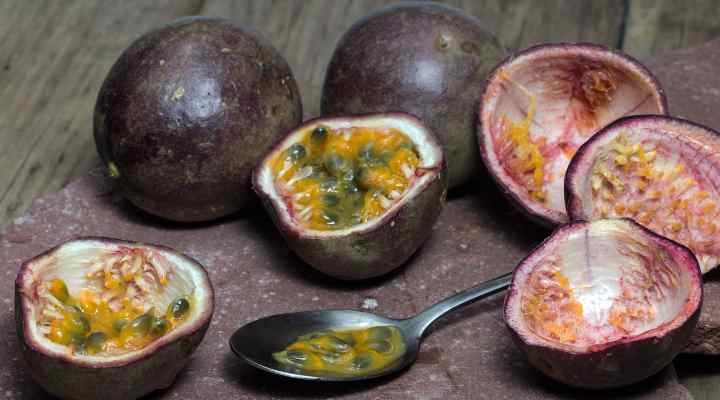
Passion fruit is a tropical purple fruit native to South America with a unique sweet and tangy flavor. This vine fruit is a type of pepo characterized by its round or oval shape and thick, smooth purple skin. The fleshy purple fruit has pulpy yellow flesh and brown seeds.
The taste of a passion fruit is often described as combining tropical fruits like pineapple, mango, and citrus. You can scoop out the pulp and enjoy it on its own, or add to desserts, ice creams, yogurt, or fruit juices for a refreshing, tropical twist.
Passion fruit grows on a perennial, purple-flowering vine. The fruits are round or egg-shaped and measure 1.6” to 3” (4 – 7.5 cm) in diameter.
Blueberry (Vaccinium sect. Cyanococcus)

Blueberries are small, round fruits with a deep blue or purple-blue color and deliciously sweet taste. Small blueberries measure up to 0.6” (1.6 cm) in diameter. However, some varieties are much smaller. These small ball-like purple berries are recognized by their flared crown at the end.
Blueberries are versatile purple fruits with various culinary uses. Apart from eating the sweet morsels fresh, you can add them to yogurt, smoothies, and oatmeal for a burst of flavor and nutrition. They also add color and sweetness to muffins, pancakes, and pies.
Scientific studies suggest that blueberries have several important health benefits. The purple-blue berries have high levels of anthocyanins and phytochemicals. Scientists say that “the regular consumption of tasty, ripe blueberries can be unconditionally recommended.”
Types of Black Fruits
Like purple fruits, black fruits owe their color to anthocyanins. Fruits with black skin or flesh, like blackberries, currants, and elderberries, contain essential vitamins, minerals, and phytochemicals, contributing to overall well-being.
Blackberry (Rubus fruticosus)

Blackberries are a type of large, edible black fruit that looks like a large dark purple raspberry. Blackberry fruits grow on fast-growing thorny shrubs. The black-colored berries can grow up to 2” (5 cm) in diameter. The difference between raspberries and blackberries is that the receptacle stays on the blackberry after picking from the canes.
Blackberries have a sweet, deep taste with slightly acidic undertones. The rich, juicy black fruits are ideal for making jams, jellies, and preserves due to their natural sweetness. Also, their vibrant color adds visual appeal, taste, and nutritional value to fruit salads, desserts, and smoothies.
American Elderberry (Sambucus canadensis)

American elderberries are small, dark purple-black fruits growing in drooping clusters on deciduous shrubs or small trees. The glossy black berries contain a lot of juice and are highly nutritious, with high levels of antioxidants. The small, shiny black berries have a slightly bitter flavor. They measure 0.25” (0.6 cm) in diameter.
It is important to note that elderberries must be cooked before consumption. Otherwise, you could suffer from nausea and digestive issues.
The deep blackish-purple color of elderberries is due to their high anthocyanin content. These tart berries have various culinary uses, including making jams, wines, and desserts used in pies and desserts. They are a delicious addition to pancakes and muffins.
Açai Berry (Euterpe oleracea)

Açai berries are small, round, blackish drupes from the Açai palm tree. The shiny black fruits grow in dense clusters, with up to 900 drupes. Each berry-like black fruit measures 0.3” (0.76 cm) in diameter. The dark skin of açai berries is thin but tough, and it surrounds a fleshy pulp that is typically 80 percent seed.
Açai berries have gained popularity due to their potential health benefits as a superfood. Whether the claims are correct or not, these black berries have a delicious chocolaty, red wine flavor with a slightly tart taste.
Indian Blackberry (Syzygium cumini)
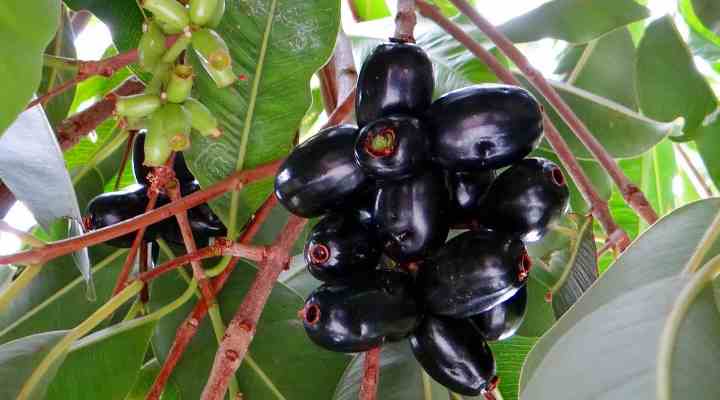
Also called Java plums or Jambolans, these small, elliptic, black drupes have a mildly sour yet sweet flavor. Jambolan fruits emerge green and gradually turn pink, crimson red, and then black as they mature. Similar in appearance to black olives, the fruit tastes sweet with slightly acidic overtones.
Indian blackberries are oblong or ovoid in shape and grow up to 0.8” (2 cm) long. Their unique taste is described as a combination of sweet, sour, and slightly astringent flavors. The black-colored fruits turn the tongue purple after eating them.
Blackcurrants (Ribes nigrum)

Blackcurrants are glossy black berry fruits with a strong, tart flavor when consumed straight off the shrub. Also called cassis, the small, round berries grow in dense clusters, dangling from the branches of shrub-like plants. They are dark purple to black and are about the size of blueberries.
Black currants have a tart taste with slightly sweet overtones. The berries are ideal for making jams and jellies due to their high pectin content. Also, blackcurrant puree is ideal for adding to yogurts, cheesecakes, sorbets, desserts, and ice creams.
Additionally, their tartness makes them ideal for use in savory dishes. They are ideal for adding flavor and nutritional content to grilled lamb, pork, roast beef, duck, and seafood.
What are the 9 Classifications of Fruits?
Fruits can be classified into different categories based on various criteria. One common classification is based on the biological characteristics of the fruit. Here are nine main classifications of fruits:
Simple Fruits: Develop from a single ovary of a single flower. Examples include peaches, plums, and tomatoes.
Aggregate Fruits: Form from multiple ovaries of a single flower. Each ovary develops into a small individual fruit called a drupelet. Examples include strawberries and raspberries.
Multiple Fruits: Develop from the ovaries of multiple flowers that are closely packed together. The individual flowers may not be readily apparent. Pineapples and figs are examples of multiple fruits.
Dry Fruits: Characterized by a pericarp (fruit wall) that becomes dry at maturity. This category includes dehiscent fruits (split open when mature) and indehiscent fruits (do not split open). Examples of dry fruits include nuts (acorns), capsules (poppy), and grains (wheat).
Fleshy Fruits: Have a fleshy pericarp at maturity. There are two subcategories:
Drupe: Has a single seed enclosed by a hard, stony endocarp (pit or stone). Examples include peaches, cherries, and olives.
Berry: Has a soft pericarp and one or more seeds embedded in the flesh. Examples include tomatoes, grapes, and bananas.
Accessory Fruits: Develop from tissues outside the ovary in addition to the ovary itself. The edible part may not be derived from the ovary. Examples include apples and strawberries.
Simple Fruits with Hard Endocarps: Includes fruits with a hard, stony endocarp that surrounds the seed. Examples include avocados and mangos.
Related articles:
